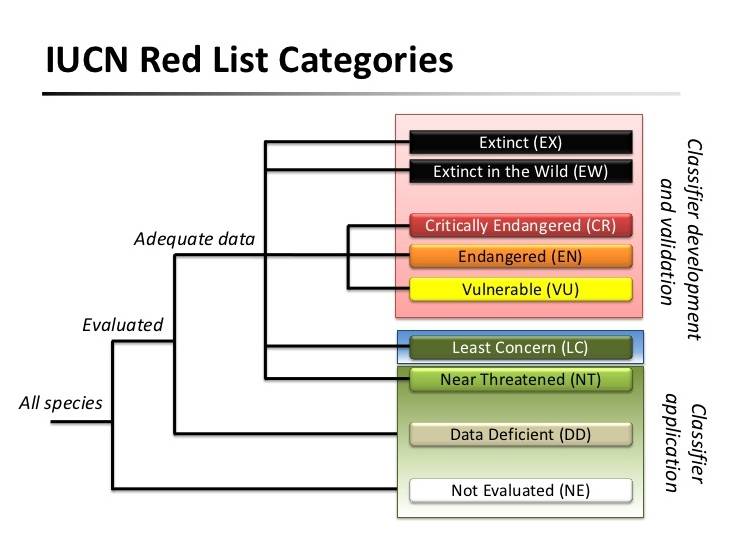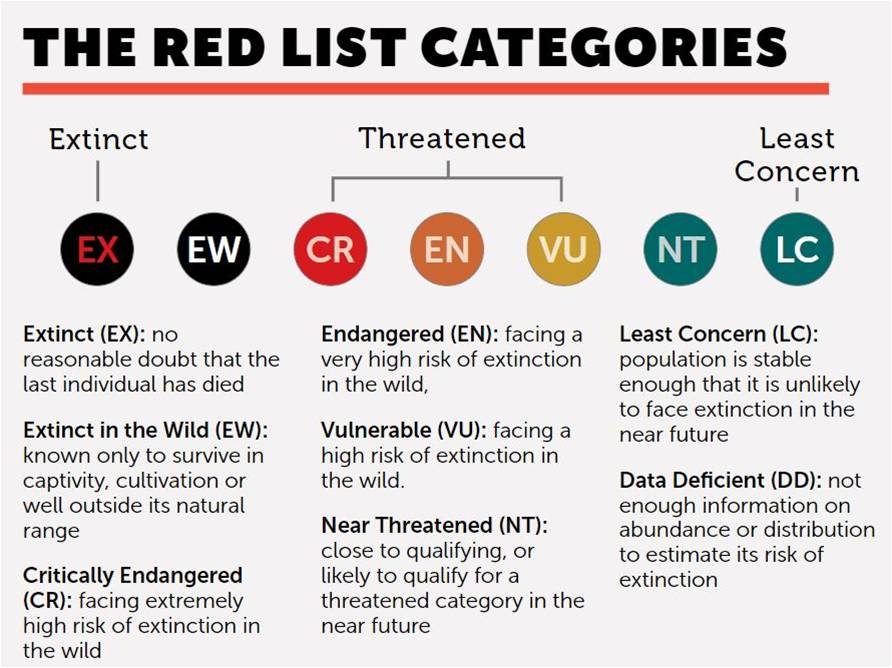Excellent study material for all civil services aspirants - begin learning - Kar ke dikhayenge!
CONCEPT – IUCN CLASSIFICATION
Read more on - Polity | Economy | Schemes | S&T | Environment
- What Is The IUCN : The International Union for Conservation of Nature (IUCN), established in 1948, is an international organization comprised of over 1,200 government and non-government members. Its objective is to promote nature conservation and sustainable use of natural resources throughout the world. This organization also focusses on issues such as poverty, gender equality, and sustainable business practices in order to address its core objective. To achieve its goal, the organization engages in field-work, data collection and analysis, lobbying, and public education outreach.
- What Is The IUCN Red List : The IUCN is perhaps best known for its Red List of Threatened Species (also known as the Red List). The Red List, established in 1964, provides the conservation status of plant and animal species around the world. IUCN members determine the risk of a species’ extinction by utilizing criteria such as population size, subpopulations, the number of mature individuals, generation, the decline in population size, extreme fluctuations in population size, fragmented populations and habitats, habitat area size, and distribution of the population.
- The Red List provides scientifically based information about species’ survival, promotes public education about biodiversity, influences governmental policies, and offers advice about conservation efforts. The category assigned to each species is reassessed every 5 to 10 years by the IUCN Species Survival Commission Specialist Groups. This list is generally accepted as the most comprehensive information on the health and conservation of the world’s species.
- What Are The IUCN Categories : The IUCN Red List assigns a specific category to each of the evaluated species. The categories and their meanings are as follows:
- Not Evaluated (NE) : Several species are categorized as not evaluated. This categorization means that the IUCN and its specialists have not yet researched the species and its risk of extinction. Examples of not yet evaluated species include: rainbow boa, eyelight fish, sugar ant, and northern brushtail possum.
- Data Deficient (DD) : A species categorized as data deficient does not have enough information available to assess its conservation status. This category does not, however, mean that research on the species has not been performed. Usually, the missing information is about population size and/or distribution. Using the data deficient label does risk miscategorizing a species, though. This is particularly true because a lack of information about population size may actually be an indicator of a very small population size. The IUCN suggests providing a different conservation status category if a significant amount has passed without updated information on the population size or distribution.
- Least Concern (LC) : The least concern species has been analyzed by the IUCN but does not qualify for any other category. Before 2001, this category was known as lower risk (LR). Any species which has not been reevaluated since changing the category (about 20%) is labeled as LR/lc. Currently, 15,636 plant and animal species are categorized as least concern. This number is further broken down as follows: 14,033 animal species, 101 animal subspecies, and 1,500 plant species. Humans are actually one of the species in this category.
- Near Threatened (NT) : The near threatened category means that the species is not currently at risk of becoming extinct in the near future. It is possible, however, that a species later becomes at risk of extinction after subsequent evaluations. This categorization usually denotes a reduction in population size or a dependence on conservation efforts. Without these conservation efforts, the species and its habitat would risk extinction. Conservation-dependent was actually a subcategory of the lower risk category before 2001. The IUCN highly recommends reassessing these species regularly to identify any changes in their conservation status.
- Some examples of near threatened species include maned wolf, narwhals, European otter, and gray bat. The gray bat was recently removed from the endangered list because of successful conservation programs.
- Vulnerable (VU) : A species categorized as vulnerable will probably become endangered in the near future due to survival threats like habitat loss and destruction. Conservation efforts aimed at habitat preservation and population increases could successfully remove the species from the list in the future. These species are monitored often and frequently become more scarce.
- Currently, there are 5,196 vulnerable animals and 6,789 vulnerable plant species. Some of these animals include the: blue crane, black-cheeked lovebird, king colobus, and yak.
- Endangered (EN) : The IUCN considers an endangered species to be likely to become extinct. This is the second most serious conservation status for wild plant and animal species. Many international regulations prohibit killing, hunting, or selling species in this category. Additionally, large areas of land have been protected in order to conserve their population size.
- Critically Endangered (CR) : A critically endangered species faces a very high risk of becoming extinct in the very near future. This is the most serious category for living plant and animal species. Within this category, some species have been labeled as “possibly extinct” or “possibly extinct in the wild.” This is because a species cannot be categorized as critically endangered until extensive research has been completed. The IUCN gives a critically endangered status if the species is only found in less than 100 square kilometers and experiences extreme habitat fragmentation, is found on less than 10 square kilometers or has declined by more than 25% over 10 years (to name a few).
- There are currently 2,464 animal species and 2,104 plant species on the critically endangered list. Some of these animals include the: Siberian crane, blue-throated macaw, Sumatran rhinoceros, and mountain gorilla.
- Extinct in the Wild (EW) : A species on the extinct in the wild list does not exist in the wild or in its historic habitat. The only recorded living species on this list are either in captivity or live in a non-native habitat due to widespread habitat destruction. There are some attempts to reintroduce these species to the wild. However, this effort can often be unsuccessful.
- Some of the animals currently on this list include Socorro dove, black soft-shell turtle, Guam rail, and Hawaiian crow.
- Extinct (EX) : Once a species is on the extinct list, it no longer exists. Of all the species that have ever lived on earth, 99% have become extinct. This is more than 5 billion species. Estimates suggest that half of the earth’s current plant and animal species will be extinct by 2100.
* Content sourced from free internet sources (publications, PIB site, international sites, etc.). Take your own subscriptions. Copyrights acknowledged.














